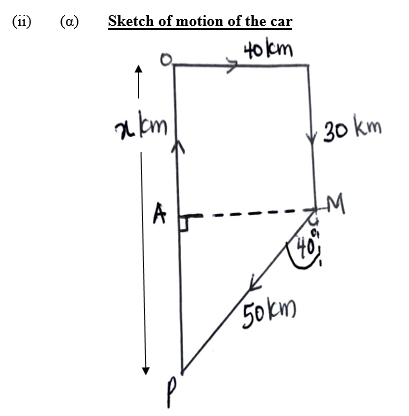Question 8
(a) (i) what are crystalline substances?
(ii) state two examples each of:
(α) crystalline substance;
(β) amorphous substance.
(b) (i) A body was placed at different points on the earth’s surface and was observed that its weight varies at different points. State three reasons for the observation
(ii) A car travels from a starting point, P, and moves x km northwards, 40 km eastwards, 30 km southwards and then gets to a point m where it turns 400 west of south at a distance of 50 km from its starting point, P.
(α) Sketch a diagram showing the directions of motion of the car at each stage. (β) Calculate the value of x
(c) State three characteristics of pressure in fluids.
Observation
The expected response:
(a) (i) Crystalline substances
They are substances whose ions/atoms/molecules are arranged in a regularly repeated pattern. [2 marks]
(ii) (α) Examples of crystalline substances
- Sodium chloride/common salt/table salt
- Zinc chloride
- Copper sulphate
- Ice
- Zinc sulphate
- Sodium sulphate
- Diamond
- Graphite
- Sodium sulphate
- Sodium nitrate
(β) Examples of Amorphous substances
- Glass
- Wood
- Paper
- Asbestos
- Plastic
- Rubber
- Coal
(b) (i) Reasons for observation
- Rotation of the Earth
- Shape of the Earth/The Earth is not a perfect sphere
- Variation in acceleration due to gravity


(c) Characteristics of Pressure in Fluids
- It is independent of the area of the containing vessel.
- It increases with depth.
- It depends on the density of fluid.
- It is equal at all points at the same level.
- It is transmitted equally in all directions at a given level.
- It is dependent on acceleration due to gravity.
